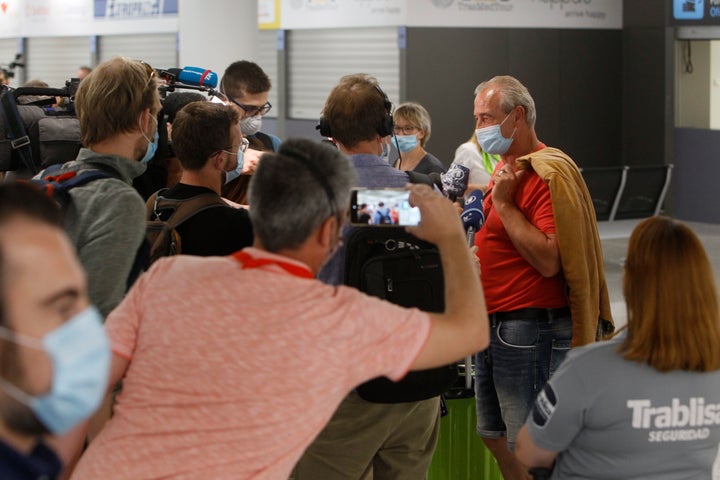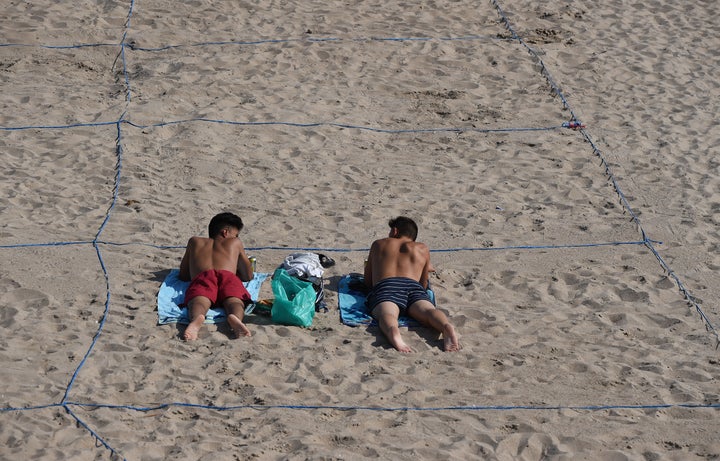This week, the first hopeful glimmers of a typical European summer emerged, as a group of German tourists flew on Monday from Düsseldorf to the Spanish hot spot of Palma, on the island of Mallorca.
“Everyone was happy on the plane,” one passenger, Kersten, told HuffPost Spain upon landing at the Palma airport.
The flight was part of a pilot program to test the idea of safe travel corridors between European countries.
Across the continent, border restrictions have begun to tumble as coronavirus infection rates have fallen, but limits on travel between certain countries remain in place. To help travelers navigate the patchwork of regulations, the European Commission has launched a website, “Re-open EU,” which offers details on travel restrictions and quarantine measures. (Visitors from the United States will likely need to wait a bit longer before travel to Europe is allowed again.)
Last week, the United Kingdom implemented a mandatory 14-day quarantine for travelers entering the country, a policy that has been hotly contested by the airline industry and tourist groups. The government has been exploring the idea of travel corridors with certain countries, including France and Spain.
In Palma, the passengers were greeted like celebrities, with throngs of camera crews documenting their arrival. At newly reopened hotels, employees applauded their first guests in months.
“Because we were the first to close and have been very responsible, we can now be the first to open,” Francina Armengol, the president of the Balearic Islands, said at a press conference.

Salvaging the tourist season is vital to reducing the economic impact of the coronavirus pandemic on the islands’ economy. But even as Spain opens its arms to foreign tourists, the fun in the sun will still come with some caveats.
Tourists are required to fill out a health questionnaire, undergo a temperature check upon arrival and provide authorities with their telephone number and the address where they are staying, so that public health services can track their health status.
Anyone who experiences possible symptoms of the coronavirus will be tested, and the government has secured apartments where patients can be quarantined if necessary.
“The operation is being very cautious, we must be clear,” María Durán, from the Mallorca Hotel Business Federation, told HuffPost Spain. “People travel in a controlled system. Officials are in permanent contact with them.”
At the press conference this week, Armengol appealed to tourists to comply with the new safety measures.
According to a group of Spanish researchers, it is “very unlikely” that bathing at the beach or in swimming pools will contribute to the spread of the coronavirus. The level of chlorine typically found in pools kills the virus, and salt water in the ocean has also been found to decrease the viral load.
But even if the water itself is safe to enjoy, the crowds of people typically found at beaches and swimming pools create a threat of transmission from person to person.
“These activities generally involve a loss of the recommended measures of social distancing,” scientists from Spain’s Higher Council of Scientific Research warned last month.
To reduce the possibility of spreading the coronavirus at pools, the Spanish government is requiring a number of safety measures. Capacity at pools is being capped at a maximum of 30%, in order to maintain social distancing. Visitors will need to make an appointment to use the pool, and showers and changing rooms must remain closed.
The requirements are more relaxed for beaches, where the only official rule is that visitors must remain at least 2 meters apart from each other. Each municipality is allowed to make its own determination about capacity, opening hours and the use of showers and changing rooms.

Some municipalities are using technology to maintain safety. The city of Fuengirola, near Malaga, on Spain’s southern coast, is using artificial intelligence to control capacity at the beaches, for example, while Valencia is developing a smartphone app that tracks how busy the beaches are.
On the Costa Blanca, the resort town of Benidorm provides perhaps the most complete picture of what future beach vacations will look like.
There, visitors must reserve a spot on the Poniente and Levante beaches via an app, portions of sand are cordoned off into sections measuring 16 square meters (approximately 13-by-13-foot squares), and ushers show tourists to their allotted parcels of sand.
Each section of beach can accommodate up to four people, and reservations require the names of each visitor. Larger groups can reserve several sections together, and there is a special zone reserved for people over 70.
At the water’s edge, a strip of sand 8 meters wide (approximately 26 feet) is roped off so that people can walk around with enough space to maintain social distancing. Anyone who simply wants to swim or stroll on the beach still needs to make a reservation.
Additional police officers have been hired to make sure that people on the beach maintain social distancing. But in the water, there’s no way to control if a kid hits someone with a beach ball, or if a tourist, asleep on an inflatable raft, runs into another person.
Local officials hope the system will be able to meet demand.
“The goal is for everyone to be guaranteed a chance to enjoy the beach. The beaches have been closed in other parts of Spain, but that’s something Benidorm can’t allow to happen. We can’t tell a tourist, ‘Come back tomorrow, the beach is closed,’” Leire Bilbao, director of the local tourism board Visit Benidorm, told HuffPost Spain.
“If necessary, we’ll start a morning and an afternoon shift to increase the number of people who can access the beach.”
The two beaches can normally host around 40,000 people, but social distancing requirements have reduced that capacity to 26,000.
With a reduction in the number of visitors, local officials predict that this summer will be challenging.
“It will be a summer to muddle through,” Bilbao said. “For the system to be profitable, it needs a lot of people, and for the moment there aren’t many. We won’t see the kind of numbers we do in other years.”
With reporting from HuffPost Spain.

